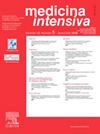小儿重症监护病房液体负荷与死亡率和发病率的关系
IF 2.7
4区 医学
Q2 CRITICAL CARE MEDICINE
引用次数: 0
摘要
目的探讨体液超载与临床预后的关系。本研究是一项回顾性队列的观察性和分析性研究。设置儿科重症监护病房。2019年至2021年间需要重症监护的儿童被纳入研究。InterventionsNo干预。评估了流体过载的初始、峰值和累积的主变量。结果死亡率为11.7%(68/513)。当从死亡率方面检查液体过载时,在幸存者组和非幸存者组中,早期液体过载的百分比分别为1.86和3.35,峰值液体过载的百分比分别为2.87和5.54,累积液体过载的百分比分别为3.40和8.16。在调整了年龄、疾病严重程度和其他潜在混杂因素后,峰值(aOR = 1.15;95% ci 1.05−1.26;p: 0.002)和累积(aOR = 1.10;95% ci 1.04−1.16;( <; 0.001)体液超载被确定为与死亡率相关的独立危险因素。当累计液体过载超过10%时,死亡率增加3.9倍。结果发现,累计流体负荷峰值与重症监护病房空闲天数、呼吸机空闲天数呈显著负相关。结论危重症患儿体液负荷峰值和累积与重症监护病房死亡率和发病率独立相关。本文章由计算机程序翻译,如有差异,请以英文原文为准。
Relationship between fluid overload and mortality and morbidity in pediatric intensive care unit
Objective
The relationship between fluid overload and clinical outcomes was investigated.
Design
This study is an observational and analytic study of a retrospective cohort.
Settings
Pediatric intensive care units.
Patients or participants
Between 2019 and 2021 children who needed intensive care were included in the study.
Interventions
No intervention.
Main variable of interest
Early, peak and cumulative fluid overload were evaluated.
Results
The mortality rate was 11.7% (68/513). When fluid overloads were examined in terms of mortality, the percentage of early fluid overload was 1.86 and 3.35, the percent of peak fluid overload was 2.87 and 5.54, and the percent of cumulative fluid overload was 3.40 and 8.16, respectively, in the survivor and the non-survivor groups. After adjustment for age, severity of illness, and other potential confounders, peak (aOR = 1.15; 95%CI 1.05−1.26; p: 0.002) and cumulative (aOR = 1.10; 95%CI 1.04−1.16; p < 0.001) fluid overloads were determined as independent risk factors associated with mortality. When the cumulative fluid overload is 10% or more, a 3.9-fold increase mortality rate was calculated. It is found that the peak and cumulative fluid overload, had significant negative correlation with intensive care unit free days and ventilator free days.
Conclusions
It is found that peak and cumulative fluid overload in critically ill children were independently associated with intensive care unit mortality and morbidity.
求助全文
通过发布文献求助,成功后即可免费获取论文全文。
去求助
来源期刊

Medicina Intensiva
CRITICAL CARE MEDICINE-
CiteScore
2.70
自引率
20.00%
发文量
146
审稿时长
33 days
期刊介绍:
Medicina Intensiva is the journal of the Spanish Society of Intensive Care Medicine and Coronary Units (SEMICYUC) and of Pan American and Iberian Federation of Societies of Intensive and Critical Care Medicine. Medicina Intensiva has become the reference publication in Spanish in its field. The journal mainly publishes Original Articles, Reviews, Clinical Notes, Consensus Documents, Images, and other information relevant to the specialty. All works go through a rigorous selection process. The journal accepts submissions of articles in English and in Spanish languages. The journal follows the publication requirements of the International Committee of Medical Journal Editors (ICMJE) and the Committee on Publication Ethics (COPE).
 求助内容:
求助内容: 应助结果提醒方式:
应助结果提醒方式:


